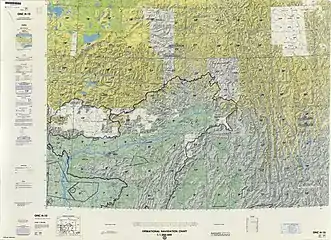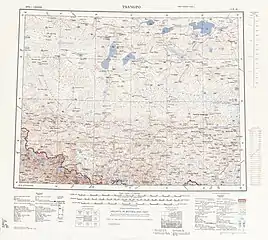Bhutan–China border
The Bhutan–China border is the international boundary between Bhutan and Tibet, China, running for 477 km (296 mi) through the Himalayas between the two tripoints with India.[1]

Description
The border starts in the west at the western tripoint with India just north of Mount Gipmochi. It then proceeds overland to the north-east, across mountains such as Jomolhari (part of this stretch is disputed). The border turns east near Mount Masang Gang, though a large stretch of this section is also in dispute. Near the town of Singye Dzong it turns broadly south-eastwards, terminating at the eastern tripoint with India.
History
The Kingdom of Bhutan and the People's Republic of China do not maintain official diplomatic relations, and relations are historically tense.[2][3][4]
Bhutan's border with Tibet has never been officially recognised and demarcated. For a brief period in circa 1911, the Republic of China officially maintained a territorial claim on parts of Bhutan.[5] The territorial claim was maintained by the People's Republic of China after the Chinese Communist Party took control of mainland China in the Chinese Civil War in 1949. Mao Zedong declared in the original 1939 version of The Chinese Revolution and the Communist Party that "the correct boundaries of China would include Burma, Bhutan and Nepal".[6] In his Five Fingers of Tibet policy, he also referred to Bhutan as a part of Tibet and therefore China.[7] In 1959, China released a map in A brief history of China where considerable portions of Bhutan as well as other countries was included in its territorial claims.[8]
With the increase in soldiers on the Chinese side of the Sino-Bhutanese border after the 17-point agreement between the local Tibetan government and the central government of the PRC in 1951, Bhutan withdrew its representative from Lhasa.[5][9][10]
The 1959 Tibetan Rebellion and the 14th Dalai Lama's arrival in neighbouring India made the security of Bhutan's border with China a necessity for Bhutan. An estimated 6,000 Tibetans fled to Bhutan and were granted asylum, although Bhutan subsequently closed its border to China, fearing more refugees to come.[5][11] In July 1959, along with the occupation of Tibet, the Chinese People's Liberation Army occupied several Bhutanese enclaves in western Tibet which were under Bhutanese administration for more than 300 years and had been given to Bhutan by Ngawang Namgyal in the 17th century.[8] These included Darchen, Labrang Monastery, Gartok and several smaller monasteries and villages near Mount Kailas.[12][13][14][15]
A Chinese map published in 1961 showed China claiming territories in Bhutan, Nepal and the Kingdom of Sikkim (now a state of India).[5] Incursions by Chinese soldiers and Tibetan herdsmen also provoked tensions in Bhutan. Imposing a cross-border trade embargo and closing the border, Bhutan established extensive military ties with India.[5][9] During the 1962 Sino-Indian War, Bhutanese authorities permitted Indian troop movements through Bhutanese territory.[5] However, India's defeat in the war raised concerns about India's ability to defend Bhutan. Consequently, while building its ties with India, Bhutan officially established a policy of neutrality.[3][5] According to official statements by the King of Bhutan to the National Assembly, there are four disputed areas between Bhutan and China. Starting from Doklam in the west, the border goes along the mountain ridges from Gamochen to Batangla, Sinchela, and down to the Amo Chhu. The disputed area in Doklam covers 89 square kilometers (km2), while the disputed areas in Sinchulumpa and Gieu cover about 180 km2.[3]
Until the 1970s, India represented Bhutan's concerns in talks with China over the broader Sino-Indian border conflicts.[3] Obtaining membership in the United Nations in 1971, Bhutan began to take a more independent course in its foreign policy.[5] In the U.N., Bhutan, incidentally alongside India, voted in favor of the PRC filling the seat occupied by the ROC and openly supported the "One China" policy.[3][4] In 1974 in a symbolic overture, Bhutan invited the Chinese ambassador to India to attend the coronation of Jigme Singye Wangchuk as the king of Bhutan.[3] In 1983, the Chinese Foreign Minister Wu Xueqian and Bhutanese Foreign Minister Dawa Tsering held talks on establishing bilateral relations in New York. In 1984, China and Bhutan began annual, direct talks over the border dispute.[3][9]
In 1998, China and Bhutan signed a bilateral agreement for maintaining peace on the border. In the agreement, China affirmed its respect for Bhutan's sovereignty and territorial integrity and both sides sought to build ties based on the Five Principles of Peaceful Co-existence.[3][4][9][16] However, China's building of roads on what Bhutan asserts to be Bhutanese territory, allegedly in violation of the 1998 agreement, has provoked tensions.[9][10][16] In 2002, however, China presented what it claimed to be 'evidence', asserting its ownership of disputed tracts of land; after negotiations, an interim agreement was reached.[3]
On 11 August 2016 Bhutan Foreign Minister Damcho Dorji visited Beijing, capital of China, for the 24th round of boundary talks with Chinese Vice President Li Yuanchao. Both sides made comments to show their readiness to strengthen co-operations in various fields and hope of settling the boundary issues.[17]
Doklam crisis, 2017
On June 29, 2017, Bhutan protested to China against the construction of a road in the disputed territory of Doklam, at the meeting point of Bhutan, India and China.[18] On the same day, the Bhutanese border was put on high alert and border security was tightened as a result of the growing tensions.[19] A stand-off between China and India has endured since mid June 2017 at the tri-junction adjacent to the Indian state of Sikkim after the Indian army blocked the Chinese construction of a road in what Bhutan and India consider Bhutanese territory. Both India and China deployed 3000 troops on June 30, 2017.[20] On the same day, China released a map claiming that Doklam belonged to China. China claimed, via the map, that territory south to Gipmochi belonged to China and claimed that it was supported by the Convention of Calcutta.[21] On July 3, 2017 China told India that former Indian prime minister Jawaharlal Nehru accepted the Convention of Calcutta.[22] China claimed on July 5, 2017 it had a "basic consensus" with Bhutan and there was no dispute between the two countries.[23] On August 10, 2017 Bhutan rejected Beijing's claim that Doklam belongs to China.[24]
Sakteng Wildlife Sanctuary
On 2 June 2020, China raised a new dispute over territory that has never come up in boundary talks earlier. In the virtual meeting of the Global Environment Facility (GEF), China objected to a grant for the Sakteng Wildlife Sanctuary in eastern Bhutan’s Trashigang District claiming that the area was disputed.[25][26][27]
Historical maps
Historical maps of the border area from west to east in the International Map of the World and Operational Navigation Chart, mid-late 20th century:
References
- "Bhutan". CIA World Factbook. Retrieved 23 September 2020.
- Sirohi, Seema (14 May 2008). "A New Bhutan Calling". Outlook. Retrieved 30 May 2008.
- Bhutan-China relations (5 July 2004). BhutanNewsOnline.com. Accessed 30 May 2008.
- India and the upcoming Druk democracy Archived 13 January 2008 at the Wayback Machine (May 2007). HimalMag.com. Accessed 30 May 2008.
- Bhutan - China relations Accessed 30 May 2008.
- "Bhutan's Relations With China and India". The Jamestown Foundation.
- Siddiqui, Maha (18 June 2020). "Ladakh is the First Finger, China is Coming After All Five: Tibet Chief's Warning to India". CNN-News18. Retrieved 19 June 2020.
- "Economic and political relations between Bhutan and the neighbouring countries pp-168" (PDF). Institute of developing economies Japan external trade organisation. Retrieved 29 June 2020.
- In Bhutan, China and India collide (12 January 2008). AsiaTimes.com. Accessed 30 May 2008.
- Institute of Peace and Conflict Studies Archived 29 May 2008 at the Wayback Machine (8 April 2008). IPCS.org. Accessed 30 May 2008.
- Bhutan: a land frozen in time (9 February 1998). BBC. Accessed 30 May 2008.
- Ranade, Jayadeva (16 July 2017). "A Treacherous Faultline". The Pioneer.
- K. Warikoo (2019). Himalayan Frontiers of India: Historical, Geo-Political and Strategic Perspectives. 149: Routledge. p. 240. ISBN 9781134032945.CS1 maint: location (link)
- Arpi, Claude (16 July 2016). "Little Bhutan in Tibet". The Statesman.
- "Ladakhi and Bhutanese Enclaves in Tibet" (PDF). John Bray.
- Bhutan Gazette (7 June 2007). BhutanGazette. Accessed 30 May 2008.
- "China hopes to forge diplomatic ties with Bhutan". Xinhua News. Retrieved 29 September 2016.
- "Bhutan protests against China's road construction". The Straits Times. Jun 30, 2017. Retrieved 2017-06-30.
- "Bhutan issues scathing statement against China, claims Beijing violated border agreements of 1988, 1998". Firstpost. Jun 30, 2017. Retrieved 2017-06-30.
- "Border face-off: China and India each deploy 3,000 troops - Times of India". Retrieved 6 July 2017.
- "EXCLUSIVE: China releases new map showing territorial claims at stand-off site". Retrieved 6 July 2017.
- "Nehru Accepted 1890 Treaty; India Using Bhutan to Cover up Entry: China". Retrieved 6 July 2017.
- PTI (5 July 2017). "No dispute with Bhutan in Doklam: China". Retrieved 6 July 2017 – via The Economic Times.
- PTI (10 August 2017). "Bhutan rejects China's claim in Doklam: China". Retrieved 10 August 2017 – via The Economic Times.
- "Bhutan counters China's claim over its territory". Phayul. 2 June 2020.
- "Why Did China Claim A Part Of Bhutan's Territory Now?". Huffingon Post. 3 July 2020.
- "China throws up another 'disputed' territory claim against Bhutan, seen as targeting India". Tibetan Review. 2 July 2020.
| Wikimedia Commons has media related to Bhutan-China border. |









